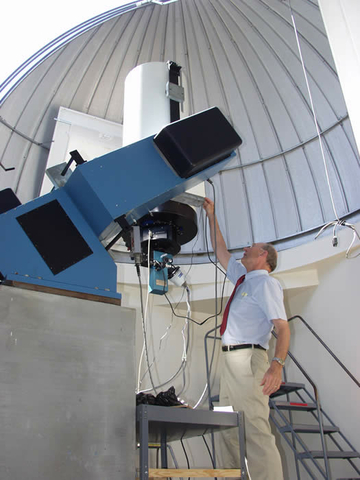The goal of Astronomy-Physics in the Chemistry Department is to enhance society’s ability to understand the Universe through the application of scientific problem solving.
Astronomy
Astronomy is the scientific study of the universe beyond the Earth. It is the oldest science and one of the seven original disciplines in the Liberal Arts. UIS offers a variety of classes which satisfy the general education requirements for physical science. Astronomy also offers opportunities for students to explore an interest through mentored research with faculty and/or involvement in the campus Space & Astronomy interest group. We also welcome and encourage community members to enroll in our astronomy classes.
Astronomy also has a public outreach mission through the UIS Observatory (see below).
Physics
Physics is the scientific study of the core principles which govern matter, energy, space and time. Principles in physics are the underlying core necessary for deeper understanding of other sciences like chemistry and biology. Physics knowledge is often also required for pre-professional exams like the MCAT and DCAT and admission to graduate school and professional programs. Students planning to attend graduate school in any scientific discipline are often expected to have introductory physics on their transcript.
Community at the UIS Observatory
We serve the public affairs mission of the UIS Campus through Star Parties and other astronomy outreach. We have a mission to nurture and grow interest in astronomy and science on campus and throughout central Illinois. Join us for one of our public events or invite us to interact with your community group.
Facilities
“Lie on your back and look at the stars.”
H. Jackson Brown, Jr. (from Life’s Little Instruction Book)
Equipment

UIS’s astronomy program possesses astronomical research and teaching equipment that is among the finest in the state of Illinois:
- 8-inch, 12-inch and 14-inch Schmidt-Cassegrain telescopes
- 8-inch Newtonian telescope
- 8-inch disability-friendly fixed-focal point telescope
- 80-mm solar telescope with integrate H-alpha filter
- 3-inch comet telescope
The Henry R. Barber Research Observatory, 25 miles
from the campus under dark skies, includes:
- 20-inch Cassegrain focus telescope
- 16-inch Schmidt-Cassegrain telescope
- Echelle spectrograph
- Diffraction-grating spectrograph
- SSP-3 Photodiode detector
- U42 CCD Camera with 20 arc minute field of view.